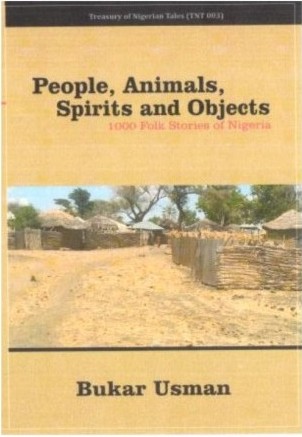|
Preserving the Treasure of Nigerian Folktales By Yemi Adebisi and Celestine Amoke
Title: People, Animals, Spirit and Objects 1000 Folk Stories Of Nigeria Editor: Bukar Usman Reviewers: Yemi Adebisi and Celestine Amoke Publisher: Klamidas Communications Ltd. No Of Pages: 939
|
||
|
Culture is the way of life of a people and one of the ways to understand it is by looking into the folklores of the communities. Yet one of the ways to perpetuate it is to ensure that the oral tradition does not die. That is what Dr. Bukar Usman has done in People, Animals, Spirit and Objects 1000 Folk Stories of Nigeria. It is an anthology of 1,000 folktales from different parts of Nigeria organised into eight sections according to the characters in the stories. The tales, which showcase the cultures of the Nigerian communities through the prism of their folktales, reflect the diverse rich oral tradition of the peoples of Nigeria. Dr. Usman, the editor of book, a prolific writer of no mean stature and President of the Nigerian Folklore Society (NFS), has written many books of the folklore genre. The book under review is just one of them. The need to preserve stories that propagate social values is one of the reasons the Dr. Bukar Usman Foundation conducted Nigerian tales collection projects that generated stories of the Treasury of Nigerian Tales (TNT) series. People, Animals, Spirit and Objects 1000 Folk Stories Of Nigeria is the third of the four books of the Treasury of Nigeria Tales (TNT) series. Others are A Treasury of Nigerian Tales (TNT001); A Selection of Nigerian Folktales: Themes and Settings (TNT002) and Gods and Ancestors: Mythic Tales of Nigeria(TNT 004). Dr. Usman explored the folktales of Babur/ Bura community, collected over 1,000 stories part of which were published in his book, The Bride Without Scars and Other Stories. The three other story books where Dr. Usman has displayed part of his rare treasure as one of the foremost African story tellers are The Hyenas and the Squirrel, Girls In Search of Husbands and The Stick of Fortunes. This was followed by 14 Hausa story books. It was while working on the books that Dr. Usman and the Foundation became aware of the rich and enormous folklore repository and felt the need to document it. The overall aim is to collect and preserve in writing the folklore of various Nigerian ethnic groups since the age-old tradition of transmitting and preserving such tales from generation to generation through oral narration is fast disappearing. The stories were collated from designated areas of Nigeria folklores – Yoruba, Hausa, Tera and Fulfude, South-South, Igbo, Sayawa and Jawara, Bauchi, Gombe and Kaduna State, Tera, North Central, Kwara and Itulo, Taraba, Southern Kaduna and Yobe State folklore narratives. The target audience of the book is children who in the traditional setting would gather around the parents or other adults to share moonlight tales most of which are not only entertaining but didactic in nature. The relevance of the book lies in the fact that parents do not have time anymore to interact with their children coupled with the fact that children are now pre-occupied by modern day technology which gives them the impression that the oral tradition of storytelling is ‘old school.’ For instance, in story 275 titled ‘The Dog and the Tortoise,’ tortoise uses its cunningness to set free all the daughters of other animals that were confiscated by the dog. There was an enemy that gained entrance into the bush that no one could conquer. The lion tried it, the enemy killed the lion. The dog was approached by fellow animals for a rescue. It accepted the offer on the condition that they will donate their daughters to it as wives if it conquered the enemy. After the eventual victory of the dog, tortoise took it to the riverside, deceiving the dog that another dog that was more powerful was inside the river. There was no escape route for the covetous dog, who jumped into the river foolishly to fight its own image. He gave up the ghost. All animals went to dog’s house to free their daughters. In Story 717, titled ‘The Dumb Boy and the Dancing Lion,’ the editor writes about a dumb boy that was hated by his friends because of his intelligence. They planned for him to die but never wanted to kill him. They went together to the lion’s den. Here, they could only escape from the hungry lion by singing for it to dance. All of them could sing and escape except the dumb boy. But when the lion realised the boy was dumb, it brought him ebony fruit which the boy ate and was able to speak at last to the dismay of his unfriendly friend. People, Animals, Spirit and Objects 1000 Folk Stories Of Nigeria surely stands in the gap to ensure that the stories continue to reverberate from one generation to the next. The stories convey cultural values of the peoples of Nigeria such as hard work, honesty, love of family and neighbour, patience, respect for elders and authorities which are all necessary in building characters of children. The stories teach the young and old alike that just as there are rewards for good traits such as generosity, respect for elders, modesty, kindness, trustworthiness and love, there are also repercussions for other negative traits such as wickedness, disobedience, telling lies, trickery, stubbornness, backbiting and the likes. The stories are written in simple English and lucid style, just as the book is well produced aesthetically to make an interesting reading for children especially those dealing with tortoise and its exploits. It is strongly recommended to cartoonists, libraries, governments, parents and other institutions that value African culture. (Courtesy: https://www.independent.ng/preserving-the-treasure-of-nigerian-folktales/amp/) |
||
